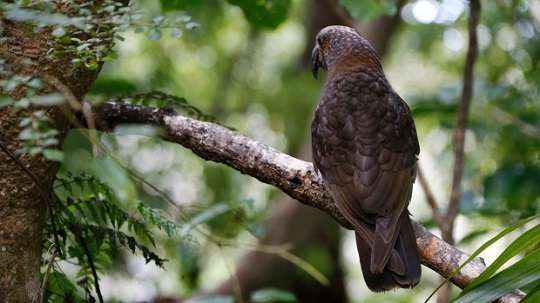Kaka conflict: conservation icon to pest
The sound and sights of kaka – cries across the valley, dog-fighting in the sky, and cart-wheeling in my kowhai tree – simply awesome.

But amongst growing numbers of people with damaged trees, fruit and, increasingly, their buildings, kaka are changing from a delight to a problem.
Kaka had been extinct in Wellington for over 100 years. They were restored in 2002 when six captive-raised kaka were released into the Karori Wildlife Sanctuary.
Their successful reintroduction and further captive releases may also have attracted kaka to Wellington from Kapiti and the Wairarapa. Provided with artificial food and nest boxes, the population has grown to over 200 birds today.
And the kaka population continues to grow rapidly. Outside Zealandia, the city has proved to be rich with natural foods and cavities for nesting, and their predators are controlled. Residents have begun feeding kaka too. Twenty-two per cent of residents visited by kaka report feeding them.
The potential, therefore, is for hundreds more kaka in Wellington, if not thousands, because the world's parrots like living in cities. They can reach higher densities in cities than they do in their native forest habitat.
Kaka damage to the Botanic Garden's collection of rare, and historically and culturally important trees was noticed first in 2009. Kaka were seen tearing bark from trees and gouging the wood deeply to feed on sap and insects.
Most of the Botanic Garden's pine, cypress and cedars will not survive the kaka onslaught. Then someone noticed the deep gouging of eucalypts and limb death in city parks and the costs of park-tree management increased.
In a 2012 survey of Wellington residents, a quarter reported problems with birds on their properties and a quarter of those problems were attributed to kaka. Fourteen per cent of respondents described the problems as moderate to severe and costly because they required the removal of damaged trees. In 2013, in the suburbs around Zealandia, 26 per cent of residents reported property damage from kaka.
Kaka are now also damaging the roofs of older city residences. We know this because, like kea in the south who have a taste for lead flashings and headed nails, some kaka are dying of lead poisoning.
Remarkably however, the contemporary attitudes of Wellington residents to kaka were positive. Over 80 per cent of people thought native birds should be in the city and that inconveniences or minor damage should be tolerated – we are a city of people highly supportive of native wildlife.
But we are much less united when it comes to managing native species that cause more serious damage. Half of us thought a native species damaging property should be controlled. The release of kaka into Wellington has initiated a new, costly and protracted human-wildlife conflict.
Perhaps reintroducing kaka to a city wasn't such a good idea – a tremendous mistake by conservationists?
As the rate and severity of damage by kaka grows, I expect support for kaka, and perhaps conservation generally amongst some, to suffer. Indeed, in a recent study residents who suffered kaka damage were less positive about kaka being in Wellington City.
Worse still, will some of those seek compensation, or for kaka to be removed or a flock destroyed?
Kaka can't be owned. Under Section 57 of the Wildlife Act, they are the property of the Crown and the Crown is not liable for the damage they may cause. But history tells a different story. If 'pushed' the Crown does sometimes, eventually accept some liabilities or at least responsibilities for solving the problem, as they have when Kaikoura seals sleep on State Highway 1 or kea mutilate high-country sheep.
Consider too that if kaka had recolonised Wellington City without assistance they would have been in small, unsupported numbers. Instead kaka are here in large and growing numbers because they were reintroduced and artificially fed and bred to be abundant by conservation organisations.
Might those organisations also, then, be responsible for kaka damage?
Like organisations that mine or harvest our natural resources, conservation organisations are also responsible for their environmental and social impact. I fear the potential of a political and legal backlash against conservation if property damage by kaka grows. This aspect of New Zealand environmental law has not been tested but it might be.
What can be done? Zealandia and local residents could stop feeding kaka and providing nesting boxes. We shouldn't be encouraging the extreme numbers that artificial food and nests supports.
And, if numbers and damage continues to grow, Kaka will need to be managed. Troublesome birds might be captured and rehomed far away. We should prepare ourselves for a time too when flocks may need to be destroyed, although perhaps usefully as a routine cultural harvest. But rehoming and culling are only temporary fixes because some kaka will find their way back and others will take their place.
Eventually and at cost, residents will need to modify their gardens and buildings so that they are less vulnerable to kaka damage.
Most importantly, conservationists must learn from the Wellington-kaka experience.
Wellington is now a city, not a forest. Just because kaka lived here once, it does not follow logically that they should live here again. Conservationists should consider people before native species are restored.
I love kaka. But their introduction to Wellington City is proving to have been a mistake.
Wayne Linklater is Associate Professor of Conservation Science and Director of the Centre for Biodiversity and Restoration Ecology at Victoria University.
